D4 and D6 are 'catch' diodes that prevent the regulators locking up should they become reverse biased for an instant at switch on. They are correct as drawn.
The power supply as drawn is 'floating' and so its up to you to connect a true ground wire if needed. For that to work, the AC input must be truly floating as well (which it is from a transformer). So yes, something like sgrossklass suggested.
The power supply as drawn is 'floating' and so its up to you to connect a true ground wire if needed. For that to work, the AC input must be truly floating as well (which it is from a transformer). So yes, something like sgrossklass suggested.
Two common (sensible) grounding schemes in turntables would be:
1. Tonearm and possibly chassis are grounded via separate ground wire to screw terminal at preamp. (Some designs use a connection to one channel's audio ground inside the chassis, which is theoretically worse but tends to work well enough in practice. I guess it won't matter much with just the tonearm being connected, but the chassis might contribute enough leakage current to make a difference.)
2. Tonearm is connected to DIN cable shield (but not audio ground) inside chassis.
A lot of DIN --> RCA adaptation jobs don't get that part right, leaving shield unconnected. Going back from a single ground return to two separate cables also introduces a (pretty small) ground loop. So general advice is not adapting but recabling properly.
There also are some stock cabling variations that are just faulty, so it's definitely worth checking how things are wired up now.
I suppose grounding the chassis (but not the tonearm) via PE would be fine in cases where the rest of the setup has a PE connection somewhere as well, which tends to be quite often these days.
Some caution is advised in any case, we are dealing with very small signal levels here and getting the grounding and shielding wrong is likely to result in hum pickup.
1. Tonearm and possibly chassis are grounded via separate ground wire to screw terminal at preamp. (Some designs use a connection to one channel's audio ground inside the chassis, which is theoretically worse but tends to work well enough in practice. I guess it won't matter much with just the tonearm being connected, but the chassis might contribute enough leakage current to make a difference.)
2. Tonearm is connected to DIN cable shield (but not audio ground) inside chassis.
A lot of DIN --> RCA adaptation jobs don't get that part right, leaving shield unconnected. Going back from a single ground return to two separate cables also introduces a (pretty small) ground loop. So general advice is not adapting but recabling properly.
There also are some stock cabling variations that are just faulty, so it's definitely worth checking how things are wired up now.
I suppose grounding the chassis (but not the tonearm) via PE would be fine in cases where the rest of the setup has a PE connection somewhere as well, which tends to be quite often these days.
Some caution is advised in any case, we are dealing with very small signal levels here and getting the grounding and shielding wrong is likely to result in hum pickup.
Hi again,
Sorry I've been away a couple of days, I had to put this project on hold to get some uni work done.
So I've probed around my turntable and figured out how it's connected.
Both the tonearm and chassis are connected to the right channels ground and the motor I assume is floating off the 240v AC in isolated from the rest (I would hope so). There is no connection to earth anywhere either (two prong connector).
I'm interested in redoing the wiring if it isn't optimal but I'm still a little unsure of what is best for this setup.
I'm still trying to get a understanding of the different ways of properly grounding.
if I connect the tonearm (and maybe the chassis) to one of the audio channel grounds do I still keep the audio ground isolated from the preamp case?
Am I meant to ground the preamp case somehow so it shields properly?
Sorry I've been away a couple of days, I had to put this project on hold to get some uni work done.
So I've probed around my turntable and figured out how it's connected.
Both the tonearm and chassis are connected to the right channels ground and the motor I assume is floating off the 240v AC in isolated from the rest (I would hope so). There is no connection to earth anywhere either (two prong connector).
I'm interested in redoing the wiring if it isn't optimal but I'm still a little unsure of what is best for this setup.
I'm still trying to get a understanding of the different ways of properly grounding.
if I connect the tonearm (and maybe the chassis) to one of the audio channel grounds do I still keep the audio ground isolated from the preamp case?
Am I meant to ground the preamp case somehow so it shields properly?
I like the idea of introducing a connection to earth on the turntable chassis as a safety thing and to reduce any noise that might be picked up from the chassis and put into the audio signal. Currently if there was a fault in the motor connection couldn't I be sending mains power through my audio path blowing up everything in it's way and making the chassis a live connection?
So assuming I'm able to isolate the tonearm from the chassis I'm thinking the connections would be:
TT chassis -> earth
tonearm -> preamp chassis via added wire+spade/grounding post
preamp circuit ground connected to preamp chassis via cap||res
Is this correct? This way the TT chassis is safer and separate from the audio path so wont induce any noise. Do I still get proper shielding from the tonearm+preamp case having them wired this way?
So assuming I'm able to isolate the tonearm from the chassis I'm thinking the connections would be:
TT chassis -> earth
tonearm -> preamp chassis via added wire+spade/grounding post
preamp circuit ground connected to preamp chassis via cap||res
Is this correct? This way the TT chassis is safer and separate from the audio path so wont induce any noise. Do I still get proper shielding from the tonearm+preamp case having them wired this way?
The turntable should really be optimally configured as manufactured. There is no easy way to describe correct grounding as a general form that would cover all cases. The things to avoid are circulating ground currents, and also connecting critical grounds to what might seem a common rail or point when in fact it has significant current flow in it (and therefore unavoidable volts drops are being generated which means that all points are in fact at slightly different potential... result is usually hum and noise).
Your motor should be 100% safe as configured by the manufacturer. Also remember shielding is a little different to grounding. Shielding can be done by connecting the relevant item to a 'quiet' part of the ground scheme safe in the knowledge that no electrical continuity exists via the shielded item into another part of the ground scheme.
Your motor should be 100% safe as configured by the manufacturer. Also remember shielding is a little different to grounding. Shielding can be done by connecting the relevant item to a 'quiet' part of the ground scheme safe in the knowledge that no electrical continuity exists via the shielded item into another part of the ground scheme.
OK I'll leave the turntable as is (chassis/tonearm connected to right audio ground).
I'm still a little unsure about a few things with this. So having the metal case grounded is done by connecting either the input or output grounds to the case. I can't do both inputs and outputs connected can I? (I currently have two sets of non isolated RCA connectors). Do I need to be strategic about where I place my 10nF capacitors? Between ground points that are further away from my input/output ground connection or close to...or just anywhere? (I assume they go between my preamp ground and the case).
I'll add a ground screw even though I wont be using it in my specific setup. So I'll have to isolate the ground screw from the preamp case since the case is connected directly to the audio ground so I can connect it to the circuit just via the 1k||100nF?
A grounded metal case is also recommended (ohmic connection at one set of inputs or outputs, a few 10 nF elsewhere), and don't forget a ground screw (connected to circuit ground via maybe 1k||100nF).
I'm still a little unsure about a few things with this. So having the metal case grounded is done by connecting either the input or output grounds to the case. I can't do both inputs and outputs connected can I? (I currently have two sets of non isolated RCA connectors). Do I need to be strategic about where I place my 10nF capacitors? Between ground points that are further away from my input/output ground connection or close to...or just anywhere? (I assume they go between my preamp ground and the case).
I'll add a ground screw even though I wont be using it in my specific setup. So I'll have to isolate the ground screw from the preamp case since the case is connected directly to the audio ground so I can connect it to the circuit just via the 1k||100nF?
You ground the metal case for one of two reasons (or both).
1/ Does the design need it for safety ?
This requires a secure connection to mains ground and ensures the user can not be put in a situation that could generate a shock (such as a live wire falling of the mains switch and contacting the case). In this situation it would be normal to have the case also connected to the power supply 'ground' somewhere on the PCB of the amp. Doing this ties the audio circuit ground to the case. Having done that, it would be normal to have all input and output grounds on their relevant sockets isolated from the case. That preserves the correct grounding scheme as provided by the board layouts.
2/ You are grounding the case merely to aid in shielding.
In this situation there is assumed to be no safety requirement needed of a mains ground, for example you might be using a separate PSU that is double insulated. Now the term 'ground' refers only to the internal circuitry and its zero volt line that we nominate and call 'ground'. Again, the case can be connected to this point to aid in shielding.
Although there is no direct mains ground as such, the case can still end up in direct contact with mains ground via interconnects coupling to source equipment that is mains grounded. If that situation occurred in the first example then you have the possibility of a 'ground loop' which could cause hum and noise.
1/ Does the design need it for safety ?
This requires a secure connection to mains ground and ensures the user can not be put in a situation that could generate a shock (such as a live wire falling of the mains switch and contacting the case). In this situation it would be normal to have the case also connected to the power supply 'ground' somewhere on the PCB of the amp. Doing this ties the audio circuit ground to the case. Having done that, it would be normal to have all input and output grounds on their relevant sockets isolated from the case. That preserves the correct grounding scheme as provided by the board layouts.
2/ You are grounding the case merely to aid in shielding.
In this situation there is assumed to be no safety requirement needed of a mains ground, for example you might be using a separate PSU that is double insulated. Now the term 'ground' refers only to the internal circuitry and its zero volt line that we nominate and call 'ground'. Again, the case can be connected to this point to aid in shielding.
Although there is no direct mains ground as such, the case can still end up in direct contact with mains ground via interconnects coupling to source equipment that is mains grounded. If that situation occurred in the first example then you have the possibility of a 'ground loop' which could cause hum and noise.
the preamp is complete! It sounds wonderful. I'm going to a friends place tomorrow to do some ab tests 🙂
Attachments
-
 20160328_002441.jpg197.9 KB · Views: 72
20160328_002441.jpg197.9 KB · Views: 72 -
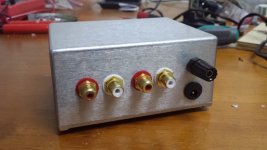 20160328_002451.jpg188.4 KB · Views: 72
20160328_002451.jpg188.4 KB · Views: 72 -
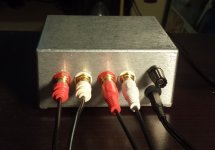 20160328_002934.jpg205.4 KB · Views: 68
20160328_002934.jpg205.4 KB · Views: 68 -
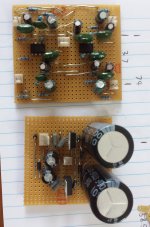 20160318_173957.jpg504.7 KB · Views: 63
20160318_173957.jpg504.7 KB · Views: 63 -
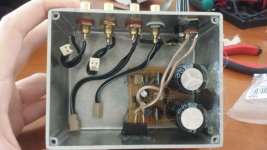 20160327_132554.jpg207.7 KB · Views: 70
20160327_132554.jpg207.7 KB · Views: 70 -
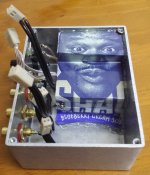 20160328_001929.jpg486.5 KB · Views: 62
20160328_001929.jpg486.5 KB · Views: 62 -
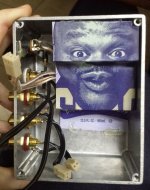 20160327_232703.jpg582.9 KB · Views: 59
20160327_232703.jpg582.9 KB · Views: 59 -
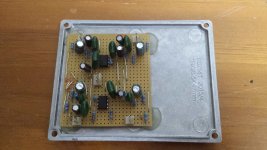 20160327_235753.jpg560.7 KB · Views: 69
20160327_235753.jpg560.7 KB · Views: 69
- Status
- Not open for further replies.
- Home
- Source & Line
- Analog Line Level
- breadboard ESD P06 Preamp not amplifying
 excellent. Thanks for sharing. And good luck with the ab tests.
excellent. Thanks for sharing. And good luck with the ab tests.